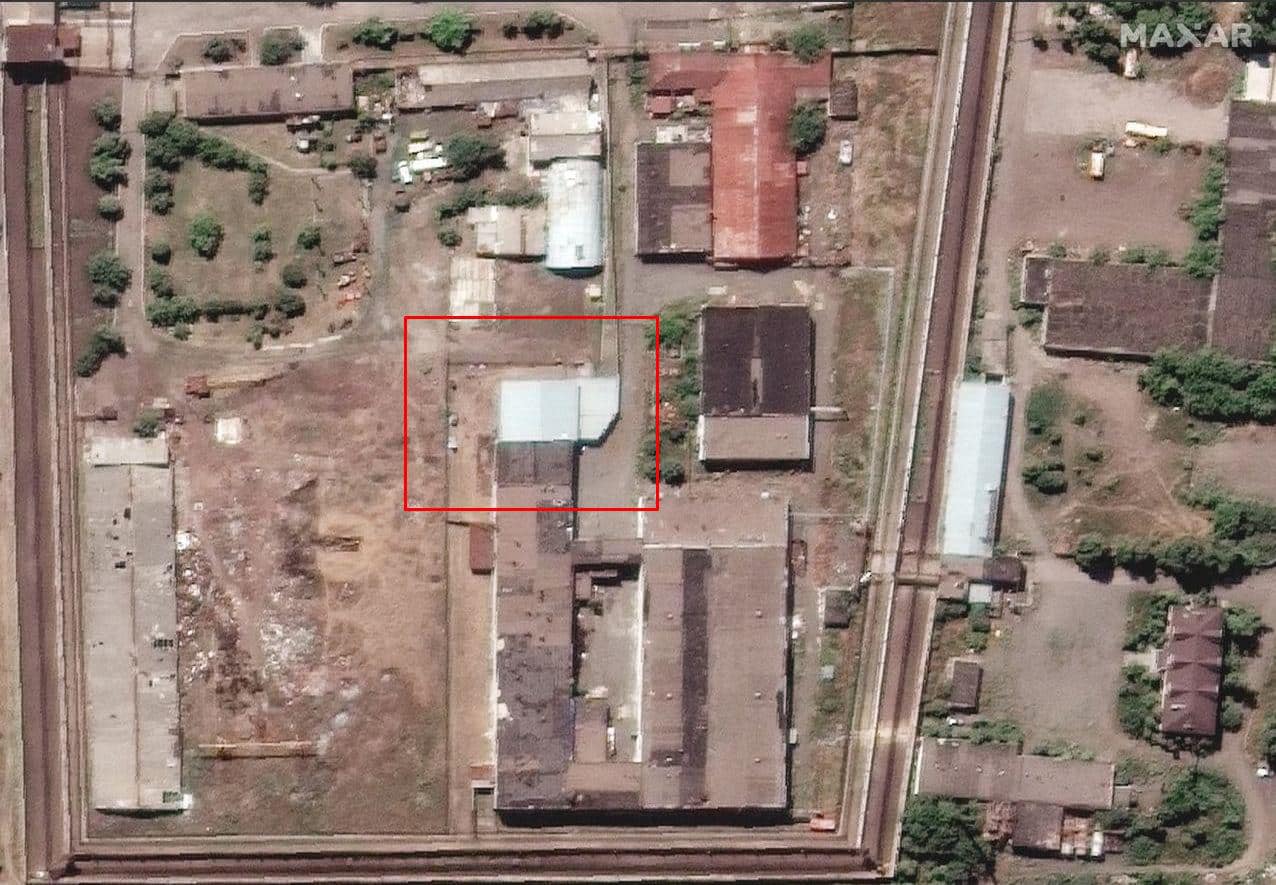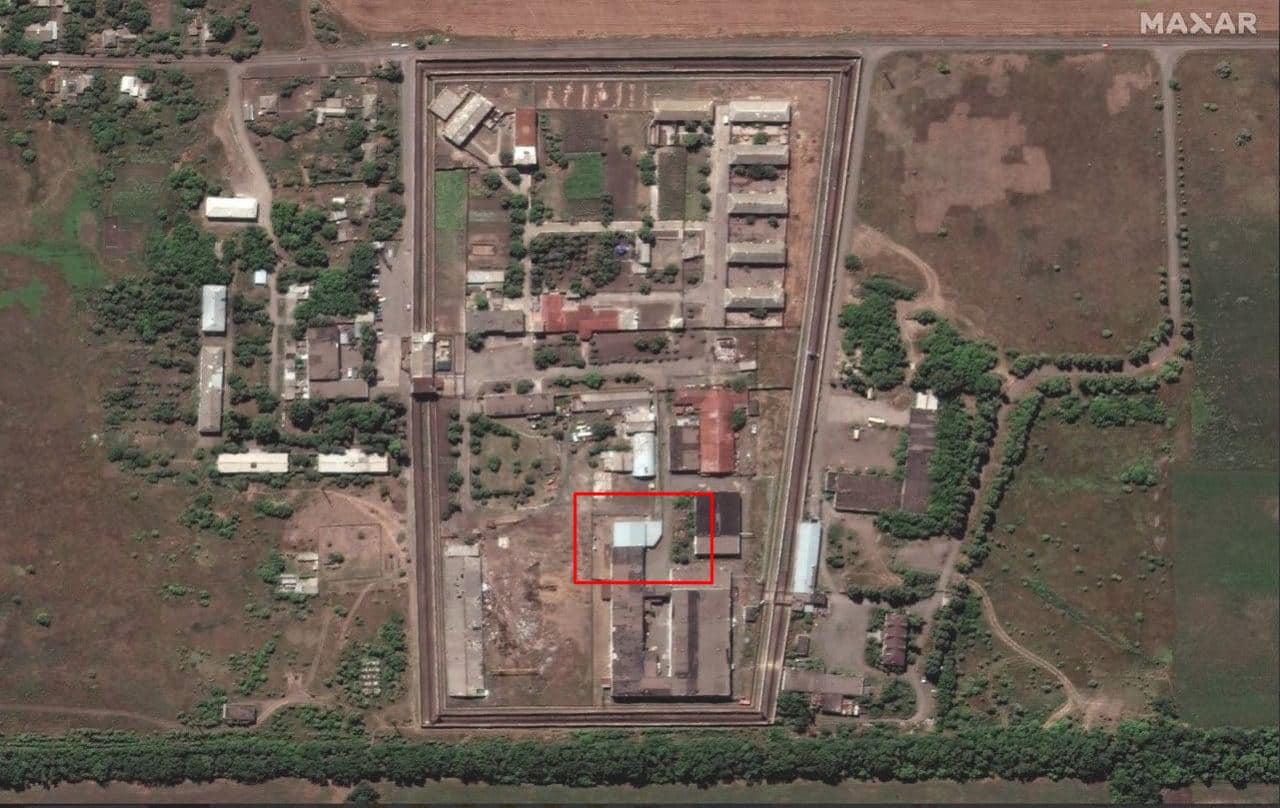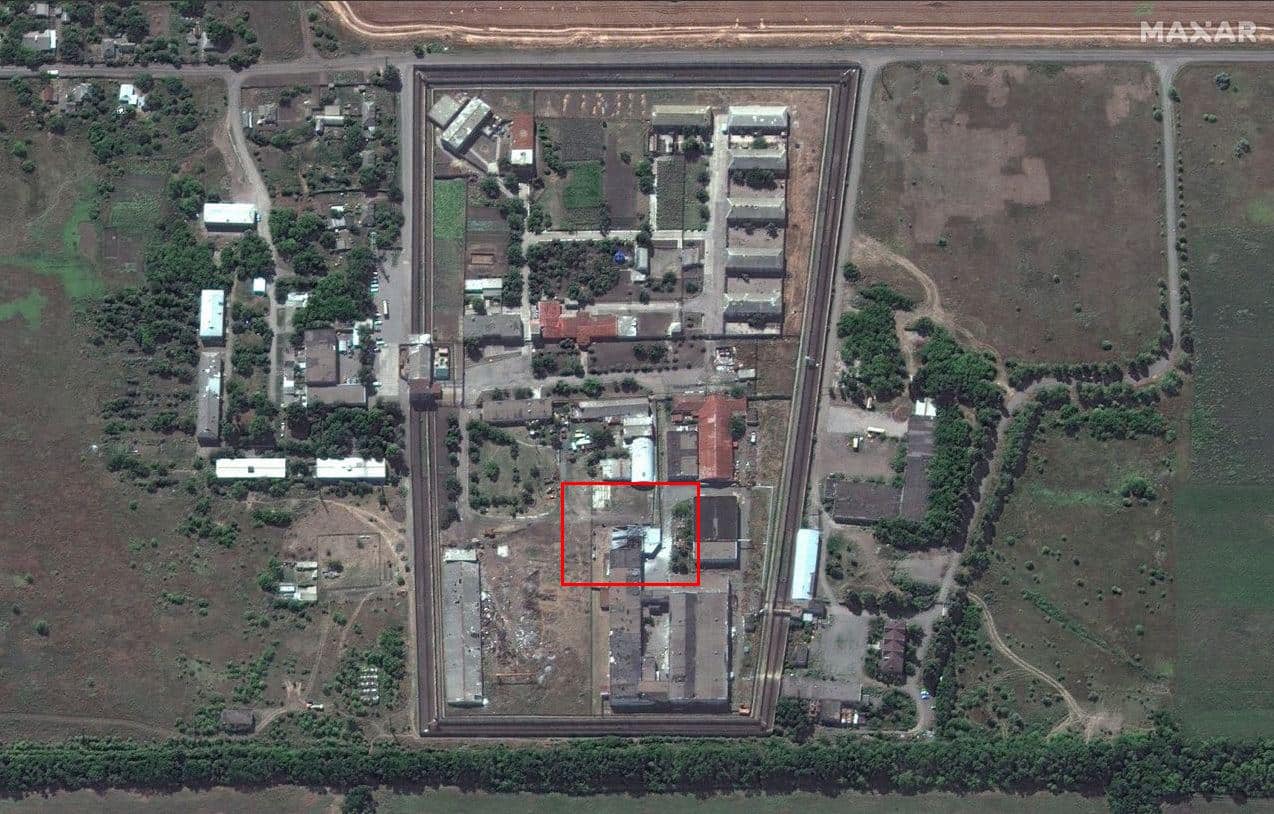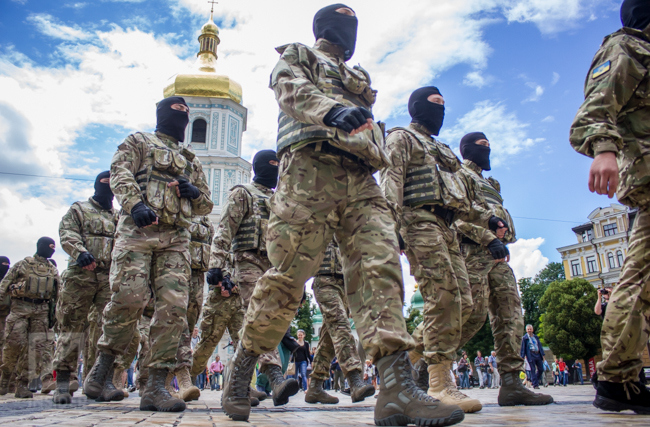On the morning of 29 July 2022, Russian propaganda media claimed a penal colony in Olenivka, near Russian-occupied Donetsk, where Ukrainian POWs were kept, was shelled. It accused Ukraine of the strike, particularly – of making it with the HIMARS MLRS. RIA Novosti reported that 53 were killed and 75 injured. Meanwhile, Ukraine accuses Russia of deliberately killing the Ukrainian POWs; Ukrainian officials have called to designate Russia as a terrorist state.
Here is everything we know about the murder of Ukrainian POWs in Olenivka prison.
What is the prison in Olenivka?
On 11 May 2022, Petro Andriushchenko, aide to the mayor of Mariupol, reported that Ukrainians from the seaside city that had fallen to Russian invaders were sent for filtration procedures to the prison colony #52 in Olenivka, a town that has been under Russian occupation since 2014. He said that native soldiers, former law enforcement officers, activists, journalists, and people who simply aroused suspicion were kept here for 36 days in unsanitary, crowded conditions, with lacking water and food.
Later on, Andriushchenko informed about a second filtration facility on the territory of Olenivka, on the territory of colony #120.
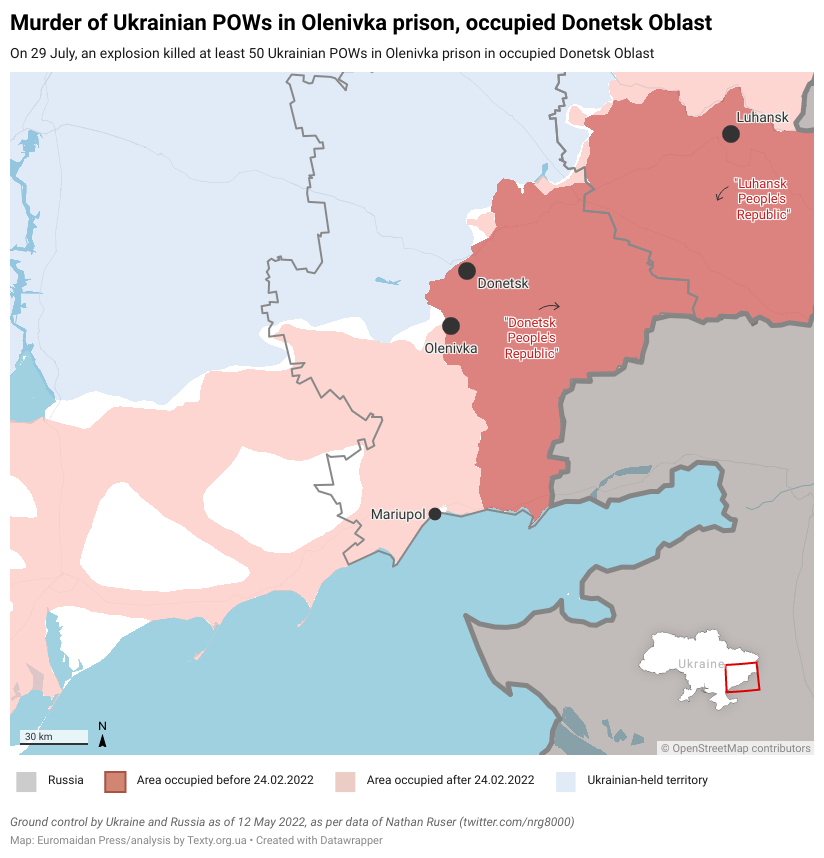
After the Mariupol garrison was given orders to stop fighting on 17 May at the besieged fortress of Azovstal steelworks and surrendered under the guarantees of the ICRC, UN, and Russia, Reuters reported that at least 250 Ukrainian servicemen were taken to Olenivka. Subsequently, one of the wives of Azovstal told The Guardian that most of the wounded servicemen of Azovstal were taken to Olenivka.
Russian propaganda coverage
On 29 July, a series of Russian state-aligned media all ran publications alleging Ukraine used HIMARS MLRS to strike the prison building with the prisoners inside, with the ostensible goal being to accuse Ukraine of using western-provided equipment to kill prisoners of civilians, thus violating international humanitarian law.
The Ukrainian fact-checking project Stop Fake analyzed Russian media publications related to the strike and found the following inconsistencies and information operations.
Priming the ground for the murder
A post
by the Nezygar Telegram channel, classified as a resource spreading Russian disinformation by Ukraine's Center for counteracting disinformation at the National Security and Defense Council, appeared to prime the public opinion for an alleged Ukrainian strike on the prison two months earlier. It claimed that Ukraine will execute a strike on the prison to blame Russia for the crime, "creating Bucha-style hype." (Thanks to the Kremlin's propaganda machine, most Russians are convinced that Russian war crimes committed in the Kyiv suburb of Bucha were staged photoshoots for the sake of discrediting Russia - Ed.).
Another narrative was spread by Russian propaganda reporter Rudenko, who staged interviews with Ukrainian POWs, most notably from the uber-demonized by Russian propaganda Azov regiment, where they are seen "confessing" to committing alleged war crimes against civilians. In one video, spread immediately before the tragedy in the Olenivka prison, a POW is seen "confessing" to "receiving the task of brutal murders from the apparatus of President Zelenskyy."
Propagandist Rudenko was one of the first to be seen at the scene of the tragedy and published a video described as "Zelenskyy executed his own people!"
Zelenskyy was subsequently accused of the tragedy not only by the Kremlin's information resources, but by Russian Duma speaker Volodin, who repeated an old trope of Russian propaganda -- that "Zelenskyy and Washington" are behind the strike to "prevent a new Nuremberg trial, where captured Azov Nazis would begin to testify."
The mechanism of how the propaganda method of POW confessions works was well described by journalist Anastasia Magazova in a twitter thread.
"A few days ago, these "war correspondents" began massively distributing their "interviews" with prisoners from the Azov battalion. They all talked about committing terrible crimes against civilians (especially in Mariupol). They confessed to everything that was attributed to them, and described in detail all the horrific crimes "committed" (I think there is no point in talking about the credibility of the information in the interviews in captivity).
Each of the captives in these videos said that they received all orders to commit these crimes directly from Zelenskyy's office. Each publication of these "interviews" ended with a rhetorical question from the "journalist": How will Zelenskyy make excuses now? What will he tell his Western partners now after these confessions by "his" heroes?
This morning I also received the first information about the shelling of Olenivka from these propaganda channels. And the main thesis in the publications about the tragedy was: "Zelenskyy ordered the execution of Azov prisoners for telling the truth". This thesis is massively circulated in Russian and propaganda sources of information - "Only Zelenskyy gave such an order".
The purpose of this campaign is to discredit the Ukrainian authorities in the eyes of Western partners and to suspend deliveries of heavy weapons, which are causing huge problems for the Rus. army. After all, according to the propagandists' version, it was a HIMARS strike." (Read the rest in the thread).
https://twitter.com/a_magazova/status/1553031436898369537?t=BiFzlcGlGreMJSBqiP_NHw&s=19
One must understand that the narrative of members of the Azov regiment allegedly "committing" war crimes is crucial for Putin's war, which has the stated goal of "denazifying" Ukraine, with fighters from Azov regiment, who defended the seaside city of Mariupol against the Russian invasion for 85 days against all odds, playing the main role of "Nazis." After the Azov fighters surrendered, they became easy prey for Russian propagandists. Show trials are expected in the near future, where with the means of forced-out confessions the Kremlin-obedient judicial system will present a propaganda trial to the Russian population to "prove" Russia had a reason for invading its neighbor Ukraine.
Inconsistencies on the day of the explosion
StopFake reports
that on the day of the explosion, the Kremlin-controlled RIA.ru reported only of an alleged Ukrainian shelling of Olenivka by ammunition of 152mm caliber, which is smaller than the missiles used by HIMARS -- 227 mm. Ukrainian fire on Olenivka was reported by the Russian-controlled "Donetsk People's Republic" coordination center which serves to inform of military activity only 10 hours after the RIA publication and there is no mention of HIMARS. The first time they are mentioned is in a post by Rudenko published 12 hours after the RIA article.
Rudenko's video was filed during the day; there are no shots of the situation in the night or early morning. There are no videos of eyewitnesses who would have filmed the "strike on the colony." There are no videos with colony employees who would have extinguished the fire.
So, no reliable footage exists of the strike. Neither is there reliable footage of fragments of GMLRS M31 rockets, used in HIMARS systems, being found at the site of the tragedy. The Institute for Study of War noted in a report that RIA Novosti released footage of HIMARS missile fragments but provided no evidence that the fragments were recovered at Olenivka.
The destruction does not look like it was done by a HIMARS
The destruction of the prison colony seen in Russian footage is inconsistent with that expected from a HIMARS strike. Here are the main moments OSINT analysts have noted.
Military expert Thomas Theiner notes it makes no sense to shell Olenivka, 15 km from the frontline, with the expensive and sparse GMLRS rockets for HIMARS that can strike for 70 km, when there are smaller systems that can carry out the strike at a fraction of the cost. As well, Theiner notes it makes no sense for the Ukrainian leadership to strike the colony, because everyone in Ukraine, including the wives of the POWs, were perfectly aware that the heroic defenders of Mariupol were located there.
The social tension that would follow after a hypothetical Ukrainian strike on the prison would be suicidal for Zelenskyy. It runs contrary to common sense.
Theiner notes that the impact of a GMLRS runs contrary to what is seen on the footage of the destroyed colony. First, the building with the tin roof is still standing, while it should have collapsed.
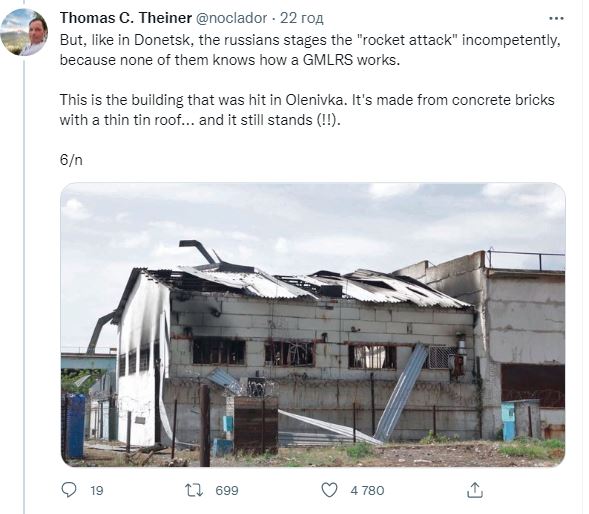
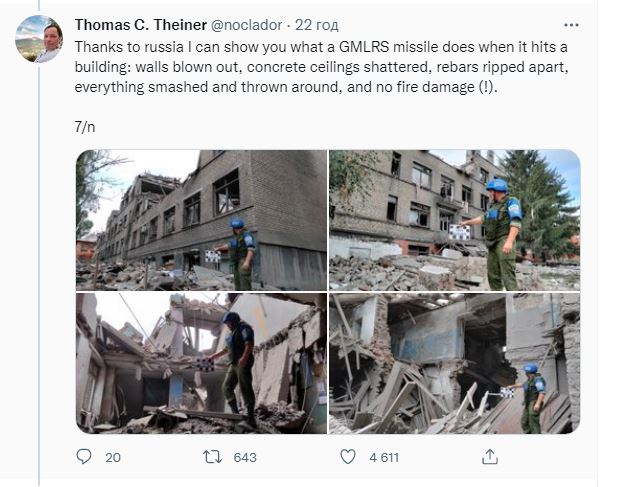
Next, Theiner notes, there is fire damage in the room, while a GMLRS strike creates none, and the beds are still standing while they should have been blown away.
"If we compare a real GMLRS impact to the staged one in Olenivka - there the explosion was so weak the beds didn't even move an inch, not a single brick was blown out, the steel pillar is undamaged, but there is massive fire damage."
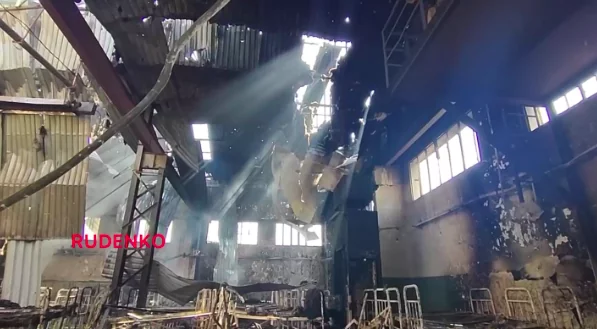
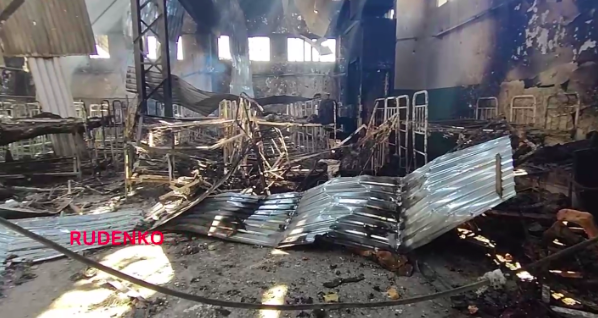
by Russian propagandist Rudenko
But the ultimate proof that this was not a HIMARS strike, Theiner says, is the absence of an impact crater. "GMLRS M31 rockets hit a target at a 90-degree angle with Mach 4+ to smash through roofs and detonate inside (and also to smash the secret guidance system, GPS components, and sensors at the tip of the missile). The tin roof of the building in Olenivka is too weak to smash in and trigger a GMLRS rocket, therefore there would have to be an impact/detonation crater in the middle of the room," Theiner explains.
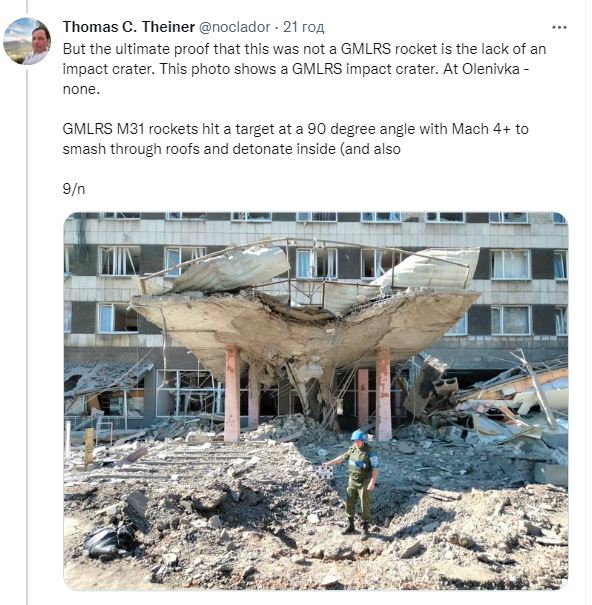
He suggests that a thermobaric weapon was used.
"If a GMLRS rocket had struck Olenivka there wouldn't be any burned bodies inside... the blast would have ripped everyone apart, not burned them alive. A thermobaric weapon burns victims, while leaving bodies intact."
Satellite images show only one building destroyed
Satellite images by Maxar technologies released after the strike show that only one building was destroyed in Olenivka (coordinates 47°49'42.41"N 37°42'38.54"E). Before: July 27. After: July 30.
Ukrainian SBU and intelligence claim proof of Russia deliberately killing POWs
Ukraine's security service (SBU) shared an intercept where alleged Russian occupiers confirm that Russian troops were responsible for the explosion in the occupied Olenivka colony. Judging from the conversations, the tragedy could have happened because of the explosives that were stored in the colony. None of the eyewitnesses heard any rocket flying toward the colony. "There was no characteristic whistling, and the explosions occurred by themselves," SBU notes. The intercepted conversations also reveal that the Russian troops placed Grad rocket launchers near the colony and fired from them into Ukrainian-controlled territory. However, no return fire followed.
In a separate statement, Ukraine's Main Intelligence Directorate (GUR) said the Olenivka blast is a terrorist attack organized by the Wagner PMC under Prigozhin’s leadership. According to the agency, the killing of Ukrainian prisoners in Olenivka was organized by the PMC on the personal instructions of Yevgeny Prigozhin, without coordination with the leadership of the Russian Ministry of Defense.
The GUR states that the explosion was carried out to cover up the theft of funds allocated to the Ukrainian prisoners. According to GUR, 0n 1 August, a commission from Russia was due to arrive at the colony to check how the funds were used and the conditions of their detention. However, the condition of the building did not meet the requirements, so the "problem" was eliminated by destroying the premises with the Ukrainians inside.
GUR added that the building was specially equipped to hold prisoners from Azovstal. Work on the building ended two days before the strike, after which some of the detained Ukrainian defenders were transferred there.
Related:
- Intercept shows Russia behind Olenivka prison strike that killed POWs; Wagner PMC involved – Ukrainian SBU, intelligence
- What is Azov Regiment? Honest answers to the most common questions
- How the West enabled genocide in Mariupol with its misguided Azov obsession


